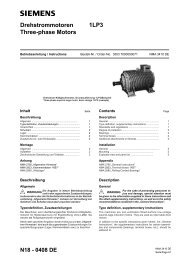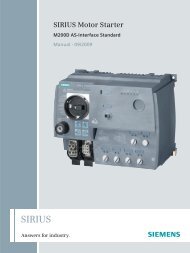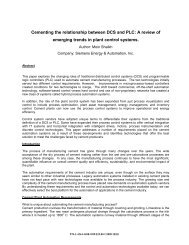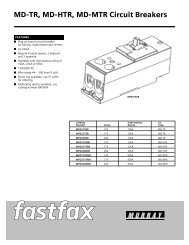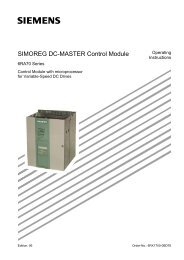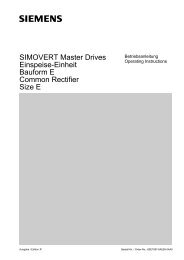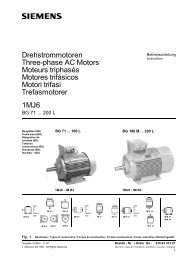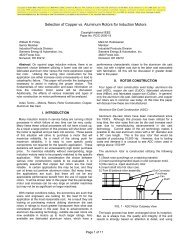WL Circuit Breakers - Siemens
WL Circuit Breakers - Siemens
WL Circuit Breakers - Siemens
You also want an ePaper? Increase the reach of your titles
YUMPU automatically turns print PDFs into web optimized ePapers that Google loves.
COM15 (PROFIBUS) / COM16 (MODBUS)Module<br />
<strong>WL</strong> <strong>Circuit</strong> Breaker<br />
The COM15/COM16 module enables the<br />
<strong>WL</strong> <strong>Circuit</strong> Breaker to exchange data<br />
via PROFIBUS/MODBUS to supervisory<br />
systems and PROFIBUS/MODBUS masters.<br />
The COM15/COM16 module retrieves<br />
some of the key data on the status of<br />
the circuit breaker (circuit breaker<br />
open/closed, closing spring charged,<br />
ready-to-close, etc.) via the CubicleBUS<br />
from the BSS (breaker status sensor).<br />
Both modules are, therefore, offered<br />
together as a PROFIBUS/MODBUS<br />
communication package.<br />
PROFIBUS Module COM15<br />
The COM15 module for the <strong>WL</strong> enables<br />
the circuit breaker to be connected to any<br />
PROFIBUS-DP system. It supports the DP<br />
and DPV1 PROFIBUS protocols, which means<br />
that it can communicate with two masters<br />
simultaneously. This makes it easier, for<br />
example, to commission parameterization<br />
and diagnostic tools and operator control<br />
and monitoring systems for the <strong>WL</strong>.<br />
CubicleBUS<br />
Graphic<br />
2-2<br />
MODBUS Module (COM16)<br />
The COM16 module enables the <strong>WL</strong> circuit<br />
breakers to be connected to any MODBUS<br />
master network.<br />
Remote control or monitoring access to<br />
the circuit breaker can be locked using<br />
hardware and software that prevents<br />
any switching operations taking place<br />
via PROFIBUS/MODBUS (manual or<br />
automatic operation) or parameters<br />
from being changed.<br />
All key events are assigned a time stamp<br />
from the integrated clock to enable<br />
operators to keep track of alarms. This<br />
device clock can be synchronized with<br />
the clock in the automation system.<br />
A temperature sensor integrated in the<br />
COM15/COM16 module measures the<br />
temperature surrounding the breaker in<br />
the switchgear cubicle.<br />
Three integrated microswitches located on<br />
the bottom of the COM15/COM16 module<br />
are used to detect the position of the circuit<br />
breaker (connect, test, disconnect and<br />
not present) and communicate the position<br />
status via PROFIBUS/MODBUS. The circuit<br />
breaker can be remotely operated only in<br />
the test or connect position.<br />
The text on the COM15/COM16 module shows the external pin configuration for closing solenoid<br />
(Y1) and the shunt trips (F1,2) as well as the PROFIBUS/MODBUS write protection function and<br />
the unassigned input/output.<br />
<strong>WL</strong> PROFIBUS/MODBUS Communication and Electronic Accessories<br />
SECTION 2<br />
Pin Configuration<br />
The COM15/COM16 module is connected<br />
to the secondary terminal block slot X8.<br />
The electrical connections to the circuit<br />
breaker and the CubicleBUS connection<br />
to the internal CubicleBUS modules (ETU,<br />
BSS, metering function, etc.) are defined<br />
in the Operator's Manual. Interposing relays<br />
must be used if the opening and closing<br />
solenoids are used with control voltages<br />
other than 24V DC.<br />
Terminals X9.1 and X9.2 must be used if<br />
the second shunt trip instead of the first<br />
shunt trip is used to open the circuit<br />
breaker via communication.<br />
Interposing relays can be used as required<br />
and must be connected in the same way as<br />
a shunt trip / closing coil (see Graphic 2-4).<br />
It can be used, for example, to reset the trip<br />
indicator if the remote reset option has<br />
been installed. As with Open and Close,<br />
only voltages of up to 24V DC are permitted<br />
(note the polarity); interposing relays must<br />
be used for higher voltage coils.<br />
The user communication port is through<br />
the 9-pin interface on the front of the<br />
COM15/COM16 module. The CubicleBUS<br />
connection for a RJ45 plug is located<br />
at the rear and is used to connect the<br />
external CubicleBUS modules. If no external<br />
CubicleBUS module is connected, the<br />
terminating resistor supplied must be<br />
used as an RJ45 plug.<br />
2/8




